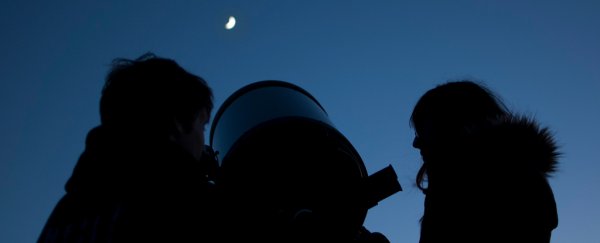This article was written by Emily Petroff, a PhD candidate in Astro Physics at Swinburne University of Technology in Melbourne, Australia. It was originally published on the Conversation.
Astronomers are trying to improve their hunt for rapid bursts of radio emission in the universe called Fast Radio Bursts (FRBs) so they can better observe these mysterious events, which are thought to occur thousands of times a day. Only nine have so far been detected.
The most recent burst was spotted in the early hours of the morning on May 15 last year when the Parkes radio telescope, in New South Wales, was observing a patch of sky in the direction of the Aquarius constellation.
This region was of interest to our team of astronomers because a Fast Radio Burst had been detected emanating from that direction back in 2011. We suspected these bursts might repeat themselves, even years later, so we visited the spot again.
While we didn't see a repeat of the old burst we did find something interesting. A new burst of radio waves lit up the receiver at preciesly 3:14am.

Within 10 seconds the detector systems working through the data identified the burst and sent an automated email to the scientists with the below subject line.
Subject: New Detection: FRB 140514.
The Parkes team sprang into action within minutes of getting the message and began emailing collaborators around the world. Coordinates were sent, telescopes were pointed, and the first multi-wavelength follow-up of a Fast Radio Burst discovery was underway.
In the days, weeks and months that followed, the location of FRB 140514 was observed with telescopes around the world and in space looking for any changes in the field that might give away where exactly the burst came from.
Unfortunately, these telescopes found nothing that could pinpoint the source or shed definitive light on its origin.
Clearly astronomers need to respond as quickly as possible when a radio burst is found if we are to better understand these curious phenomena and their causes.
Fast Radio Burst origins
Fast Radio Bursts first attracted the attention of the astronomical community when the first event was discovered in 2007 (in archival data recorded in 2001).
Since then, only nine more bursts have been found including the one picked up last year by the CSIRO's Parkes radio telescope.
At the moment we don't know for certain what is causing these mysterious bursts that we're so eager to find.
Since these flashes occur on millisecond timescales, whatever it is has to be very bright, and very short-lived. Current contenders are things like giant flares from energetic stars called magnetars or the collapse of a neutron star to form a black hole.
In either case, the sources are believed to be billions of light years away, in galaxies spread out across the universe.
How do we know they originate so far away from us? Astronomers have been using radio pulses to study the space between stars for years. The vacuum of space is not quite empty and contains a small number of particles per cubic metre.
Radio pulses travelling through this medium encode information about how many particles they have encountered on their way from a source to our telescope. This gives us a measure of the average density of the space between stars, or the interstellar medium.
Fast Radio Bursts appear to have travelled through about ten times more particles than we expect from the Milky Way. To account for all those particles, the burst must have also travelled through the intergalactic medium as well, putting their sources billions of light years distant.
If the exact distance to a burst could be measured with an optical telescope, the information from these bursts could be used to determine the "weight" of the universe in a particular direction, something that has never before been possible.
While the Parkes telescope is good at finding these radio bursts, telescopes at other wavelengths will ultimately be the next important step in pinning down their origin and natures.
If they give off light at other wavelengths, like X-rays or visible light, picking up important new clues will require a fast response from other telescopes when a radio detection is made.
In the case of FRB 140514, the first multi-wavelength observation didn't occur until eight hours after the radio burst, preventing us from saying anything definitive about the source.
Rapid response
Part of the problem in observing these Fast Radio Bursts is that they only last for a few milliseconds, and the universe is a very big place to look for them.
So finding where they come from means we need to think about more real-time observations and developing a speedier and more collaborative approach to observing any new bursts. The next big breakthrough in the puzzle will come from a faster response to observing and a multi-wavelength effort.
Doing this requires many people. No single individual can watch for bursts 24 hours a day, and no single person can operate dozens of telescopes simultaneously to get the necessary data. Collaborative teams are becoming more important than ever.
The most comprehensive effort currently underway is the Survey for Pulsars and Extragalactic Radio Bursts (SUPERB) at Swinburne University.
The aims of the survey, besides finding new Fast Radio Bursts, are to foster international collaboration and develop a robust and fast method for alerting other telescopes with the next real-time discovery.
Ultimately, all we can do is wait for the next burst. Finding a needle in a haystack requires being in the right place at just the right time.
But with more eyes prepared to look and a speedier response we might have a better chance of finding where Fast Radio Bursts really come from.
Love science? Find out more about the ground-breaking research happening at Swinburne University of Technology.
![]() This article was originally published on The Conversation. Read the original article.
This article was originally published on The Conversation. Read the original article.
